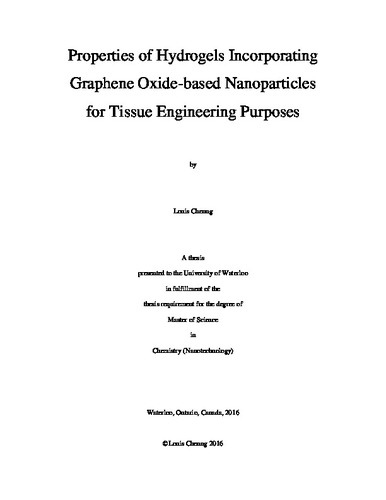| dc.description.abstract | Tissue engineering involves designing and fabricating scaffolds for tissue regeneration and replacement. Much research has focused on identifying the key factors that affect scaffold performance and the necessary material properties. Nanotechnological approaches have been applied towards tissue engineering and the development of novel biomaterials for scaffold fabrication, such as the incorporation of nanomaterials to supplement the properties of traditional materials. The current work involves the synthesis of graphene oxide (GO) decorated with magnetite nanoparticles to impart magnetic properties to GO, intended for providing anisotropic mechanical reinforcement in hydrogels. Co-precipitation and thermal decomposition were explored as synthesis routes, suggesting that co-precipitation yielded colloidally stable nanoparticles while thermal decomposition yielded magnetite with better crystallinity. The synthesized GO decorated with magnetite, GO-Fe3O4, was incorporated into alginate hydrogels and the mechanical properties were explored. It was shown that GO and GO-Fe3O4 enhanced hydrogel stiffness to similar extents. Due to its rigid nature, hydrogels incorporating GO-Fe3O4 tended to fracture at lower strains. Anisotropic alignment and mechanical reinforcement could not be demonstrated due to the synthesized GO-Fe3O4 having insufficient magnetic response. As another strategy to enhancing the mechanical properties of hydrogels, GO was covalently attached to alginate polymer chains (GO-EDA-alginate). Mechanical tests indicated that GO-EDA-alginate does not increase the stiffness of the hydrogel, but enhances the toughness, which can be due to improved interactions between GO and the polymer phase, leading to better energy dissipation. Finally, the use of alginate as a scaffold material was explored by investigating cell viability. It was shown that the crosslinking process was cytotoxic, although modifications to the protocol could alleviate the problem, in part. The current work demonstrates the use of GO-based nanoparticles as reinforcing nanofillers which could be extended to polymer systems beyond alginate. It is anticipated that magnetic ordering can lead to anisotropic material properties, such as mechanical properties and electrical conductivity. This material could also find application in providing mechanical stimulation to cultured cells via application of an external magnetic field. | en |

